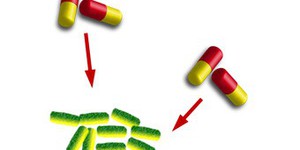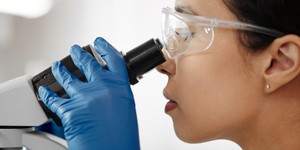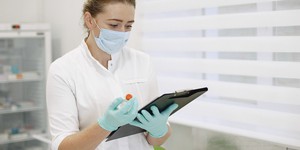How Antibiotic Resistant Bacteria Take Over
Summary
Introduction
Have you ever had to take antibiotics? Your doctor probably told you to finish taking all the pills even if you felt better after one or two days. But why is that? Why shouldn't you stop taking antibiotics as soon as you feel better? You might be surprised to hear that if you do, you might contribute to the creation of antibiotic resistant "superbugs!" Find out how these superbugs can develop in this activity by rolling dice to model how different bacteria respond to an antibiotic treatment.
Materials
- Six-sided dice (20 total. 15 of one color, 5 of another color.) Note: Alternatively, you can use an online dice roller.
- Paper
- Pen
- Graphing paper (optional)
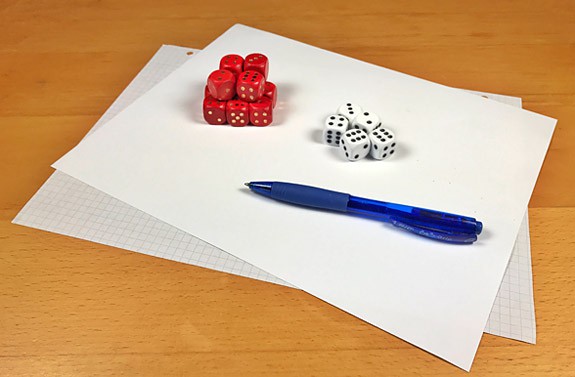 Image Credit: Svenja Lohner, Science Buddies / Science Buddies
Image Credit: Svenja Lohner, Science Buddies / Science Buddies
Prep Work
Instructions
- Make two piles with the two different-colored dice. In your model, each die represents one bacterium.Which pile do you think represents the non-resistant bacteria, and which one the more resistant bacteria?
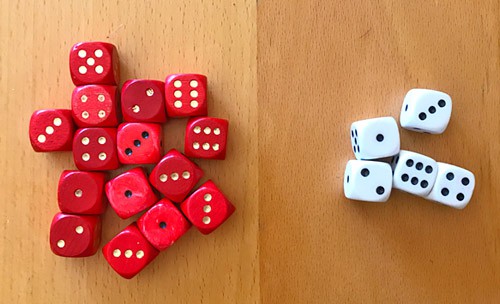 Image Credit: Svenja Lohner, Science Buddies / Science Buddies
Image Credit: Svenja Lohner, Science Buddies / Science Buddies
- Write on your paper which color represents which bacteria. (Tip: In nature, non-resistant bacteria are most abundant. Bacteria that are more resistant to antibiotics are luckily still less in number.)
- In your simulation, each roll of the dice corresponds to taking one dose of antibiotics. More resistant bacteria survive the antibiotics when the roll outcome for these dice is a 2, 3, 4, 5, or 6. Non-resistant bacteria survive when the roll outcome for these dice is a 6.How are the survival probabilities different for the non-resistant versus the more resistant bacteria?
- Mix all your dice together and roll them. Separate the rolled dice into a "surviving" pile and a "died" pile based on the roll outcome of the individual dice and the rules mentioned in step 3.
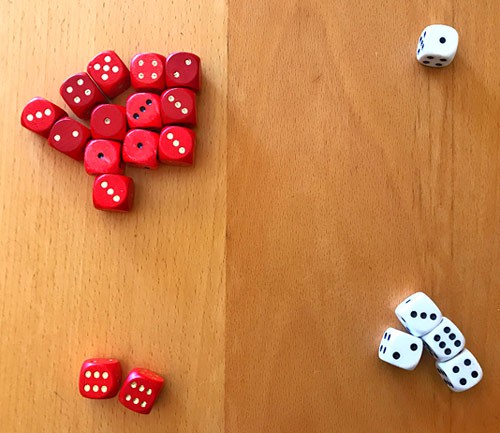 Image Credit: Svenja Lohner, Science Buddies / Science Buddies
Image Credit: Svenja Lohner, Science Buddies / Science Buddies
- Set all the dice in the "died" pile aside. They will not be used anymore. Count how many dice of each color are in the "surviving" pile and record your results on a piece of paper.How many bacteria survived? How many of the more resistant or non-resistant bacteria died?
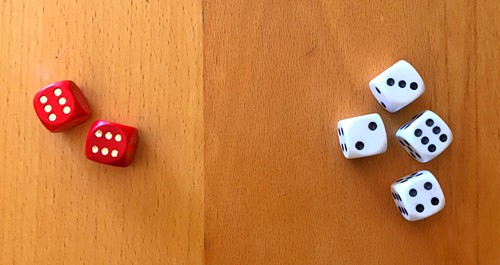 Image Credit: Svenja Lohner, Science Buddies / Science Buddies
Image Credit: Svenja Lohner, Science Buddies / Science Buddies
- Repeat steps 4 and 5 until no dice are left. Record your results every time you roll the dice.How many rolls does it take to kill all of the more resistant bacteria? Do the more resistant bacteria survive longer or for less time compared to the non-resistant ones? Why do you think this is the case?
What Happened?
Were you able to kill all the bacteria? Probably yes, but it might have taken you some rounds of rolling the dice to do so. You probably noticed that the "normal," or non-resistant bacteria got killed off pretty quickly. As they only survived in your model when the roll outcome was a 6, and with 6 possible numbers on the die, the probability for them surviving one roll (representing one dose of antibiotics) was only 1 out of 6, which is 16.6%. It shouldn't have taken more than 3 or 4 rolls to eliminate all non-resistant bacteria.
However, the more resistant bacteria in this model have a survival probability of 5 out of 6, or 83.3% for each roll, as they survive when a 2, 3, 4, 5, or 6 is rolled. This means that it should have taken much longer to kill all the more resistant bacteria. Even though they start out at a much lower number than the non-resistant bacteria, after 3-4 rolls, they should be the only ones alive. It probably took you up to 10 or even more doses of antibiotics (or dice rolls) to kill them all.
This is exactly what happens in real life with the real bacteria. One dose of antibiotics is very efficient in killing off bacteria that can't resist the effects of the drug. However, bacteria that can defend themselves against the antibiotics are able to survive the first dose and it will take several doses of treatment to kill them. Keep this in mind for the next time you have to take antibiotics. Take them responsibly, so you can avoid the creation of superbugs!
Digging Deeper
Bacteria are microscopic organisms that are found everywhere. They are even inside and outside our bodies! Most bacteria are harmless to humans, but some can cause serious illnesses. Any microorganism that makes us sick is called a pathogen. Antibiotics are drugs that are used to kill pathogens responsible for a bacterial infection such as strep throat or ear infections. Before the discovery of the first antibiotic, penicillin, in 1928 by Alexander Fleming, people frequently died from minor wounds and infections (things we might think of as trivial injuries, like a scraped knee). Today, penicillin is estimated to have saved between 80–200 million lives.
However, many antibiotics have lost effectiveness because bacteria have become resistant to them over time, generating bacteria that are known as "superbugs." Antibiotic resistance means that the bacteria have gained the ability to resist the effects of the drug that used to kill them. Antibiotic resistance is created when the bacteria's genetic material mutates in a way that makes them less susceptible to the drug or allows the bacteria to deal with the antibiotic before it can do any harm. Such mutations can happen when bacteria are unnecessarily exposed to antibiotics and can be caused when people take antibiotics when they don't need them, improperly dispose of antibiotics, or take antibiotics in the wrong time period during a bacterial infection.
An antibiotic treatment kills non-resistant bacteria pretty quickly and selects for the bacteria that are more resistant to the drug. The surviving bacteria are more likely to become antibiotic resistant and replace the bacteria that have been killed. This selection is based on the fact that not all bacteria are the same, which means that some bacteria can be more resistant to a certain antibiotic than others. This also explains why it is not enough to take antibiotics just once when you are sick. As some bacteria have better strategies to resist the drug, they will survive one dose of antibiotics and it will take more doses to kill them.
There is little research on what the perfect treatment time for antibiotics is, especially as it is also very dependent on what bacteria are causing the illness. However, scientists agree that either taking antibiotics for too short or long a time increases the risk of creating antibiotic resistances.
Ask an Expert
For Further Exploration
- Increase the number of dice for each bacteria group or change the ratio of more resistant versus non-resistant bacteria. How does this change your results?
- Use graphing paper to graph your results. On the horizontal axis, write the number of doses (or how often you have been rolling the dice), and on the vertical axis graph the number of survived bacteria after each dose. How do your graphs for the more resistant versus non-resistant bacteria compare?
- Change the rules in your model and change under what conditions (or roll outcomes) the bacteria survive. Alternatively, you can add 10 "mildly resistant" bacteria represented by 10 dice of a third color to your bacteria mix. Let these bacteria only survive when the roll outcome is 4, 5, or 6. What results do you get with three different kinds of bacteria?
Related Resources
Project Ideas
Lesson Plans
- MS-LS4-4. Construct an explanation based on evidence that describes how genetic variations of traits in a population increase some individuals' probability of surviving and reproducing in a specific environment.
- MS-LS4-6. Use mathematical representations to support explanations of how natural selection may lead to increases and decreases of specific traits in populations over time.






